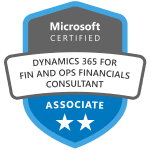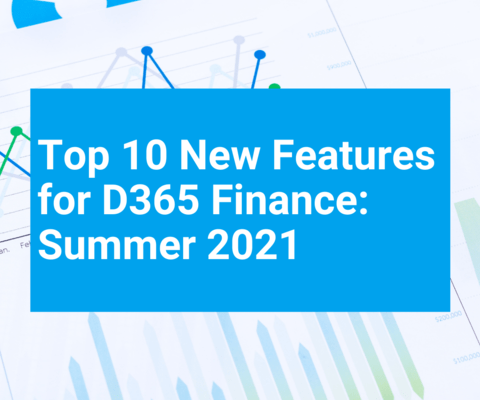Microsoft Certified: Dynamics 365 Finance Functional Consultant Associate
This preparation guide includes information and tools to assist you in preparation to become Microsoft Certified: Dynamics 365 for Finance Functional Consultant Associate.
Microsoft Certified: Dynamics 365 Finance Functional Consultants unify global financials and operations and automate tasks and workflows, streamline customer ordering, selling, invoicing, and reporting.
D365 Finance Functional Consultant Associate
In order to achieve this certification, you must pass two exams:
Exam MB-300: Microsoft Dynamics 365 Core Finance and Operations
Instructor-led training for MB-300
Exam MB-310: Microsoft Dynamics 365 Finance
Instructor-led training for MB-310
Skills measured
This exam measures your ability to accomplish the technical tasks listed below. The percentages indicate the relative weight of each major topic area on the exam. The higher the percentage, the more questions you are likely to see on that content area on the exam. Please note that the questions may test on, but will not be limited to, the topics described in the bulleted text.
*** Topics from exam MB-300: Microsoft Dynamics 365 Core Finance and Operations ***
Use common functionality and implementation tools (20-25%)
Identify common Microsoft Dynamics 365 Finance and Operations features and functionality
- determine when to use workspaces
- identify use cases for mobile workspaces, Power Apps, and Flow
- identify and differentiate between the global address book and other address books
- determine when and how to use the Data Expansion Tool
- demonstrate Work Items functionality
- demonstrate Microsoft Dynamics 365 Finance and Operations navigation techniques
- identify Inquiry and Report types available in a default installation
Implement Lifecycle Services (LCS) tools
- identify opportunities to re-use existing assists
- analyze Business Process Modeler results and identify gaps in functionality
- use the LCS tools including Issue search and analyze results
Configure security, processes, and options (45-50%)
Implement security
- identify and distinguish between standard Finance and Operations security roles
- distinguish between duties, privileges, and permissions
- assign users to security roles based on given scenarios
Design and create workflows
- identify opportunities for automation and controls based on customer workflows
- configure workflow properties and elements
- troubleshoot workflows
Configure options
- set up and configure legal entities
- configure base number sequences
- import or create postal data
- configure the calendars and date intervals
- configure units of measure and conversions
- configure posting profiles and definitions
- create organization hierarchies
- apply purposes and policies
- describe and apply user options
Implement Microsoft Dynamics 365 Finance and Operations common features
- synchronize Microsoft Office information with Microsoft Dynamics 365 Finance and Operations
- configure email (SMTP/Exchange)
- create and maintain email and record templates
- set up a Power BI connector
- create, export, and import personalizations
- set up network printing
Implement business processes for the solution
- define use case scenarios
- participate in phase-based planning processes and the solution design
- design and create workflows
- set up batch jobs and alerts
- use business process workspace
Perform data migration (15-20%)
Plan a migration strategy
- identify common migration scenarios and tools in Microsoft Dynamics 365 Finance and Operations
- determine migration scope
- identify relevant data entities and elements based on given scenarios
- establish migration strategy processes
Prepare data for migration and migrate data
- identify and extract source data
- generate field mapping between source and target data structures
- support the transition between the existing and migrated systems
- perform a test migration and validate output from the process
Validate and support the solution (15-20%)
Implement and validate the solution within Microsoft Dynamics 365 Finance and Operations
- perform user acceptance testing (UAT)
- build test scripts to test business functionality
- demonstrate the correlation between test scripts and business requirements
- monitor validation test progress and make ad hoc changes during validation testing to correct identified issues
Support Application Lifecycle Management (ALM) by using LCS
- perform a solution gap analysis
- use LCS tools to identify, report, and resolve issues
*** Topics from Exam MB-310: Microsoft Dynamics 365 Finance ***
Set up and configure financial management (35-40%)
Implement and configure financial modules
- configure and apply accrual schemes
- configure cash flow reports
- configure the letter of credit and letter of guarantee templates
- set up intercompany accounting
- create and configure account structures
- configure other modules including cash and bank management and budgeting
Implement and test advanced features
- implement posting definitions
Implement and test cost and allocation policies
- implement cost accounting processes
- implement inventory costing versions
- implement item groups
- create and process Ledger allocation rules
- demonstrate the use of cost accounting terminology
- construct fiscal calendars, years, and periods
Perform periodic processes
- configure financial period close
- define and demonstrate periodic closing processes and end-of-year processes
- demonstrate regional tax reporting capabilities
- perform bank reconciliation
- perform financial consolidation
- create a cost accounting report by using the cost accounting Report Wizard
- allocate funds by using accounting distributions
Configure, collect, and report taxes
- configure tax components
- implement and test end-of-year tax reporting
- prepare periodic filings
Manage and apply common processes (20-25%)
Define and configure the account structure
- demonstrate the advanced ledger entries functionality
- set up derived financial hierarchies
- demonstrate financial consolidation and elimination processes
- set up funds
- define and configure the main account
- define and configure the financial dimensions and dimension sets
- perform financial statements
- perform tracking of posted transactions
Implement regulatory and localization features and manage currencies
- set up legal entity currencies and conversions
- configure currency exchange rate providers
- implement foreign currency revaluation processes
- determine which regulatory and localization features to apply to a given scenario
Implement and manage journals
- identify the different types of journals available and their setup
- set up journal controls
- configure the journal posting restriction rules
- configure approval processes by using workflows
- create voucher templates
- perform daily procedures using journals
Implement and manage accounts payable and receivable (20-25%)
Implement and manage Accounts receivable
- set up customer posting profiles
- manage delinquent customers
- configure billing codes for free text invoices, process orders, invoices, and payments
- configure and process credit and collection
- configure customer payment setup
- prepare and send customer account statements
- configure accounts receivable charges
Implement and manage Accounts payable
- configure invoice validation policies
- set up vendor posting profile, process orders, invoices, and payments
- configure the Vendor collaboration module
- configure vendor payments
- configure accounts payable charges
Manage budgeting and fixed assets (15-20%)
Configure and manage Budgeting processes
- configure budgeting components
- create a budget plan template
- create a budget plan by using the budget plan wizard
- perform the budget planning process
- configure budget controls
- create and demonstrate registry entries
- implement budget workflows
Implement and manage Fixed assets
- create fixed assets and fixed asset groups
- configure fixed asset parameters
- identify when to enable integration with purchasing and sales module
- perform acquisition, depreciation, and disposal of fixed assets
*** Preparation options for Microsoft Certified: Dynamics 365 Finance Functional Consultant Associate ***
Instructor-led training for MB-300
Instructor-led training for MB-310
Schedule exams
Schedule the exam at Microsoft
More information about D365FO exams
View the complete list of Microsoft Dynamics 365 FO Certification Exams

